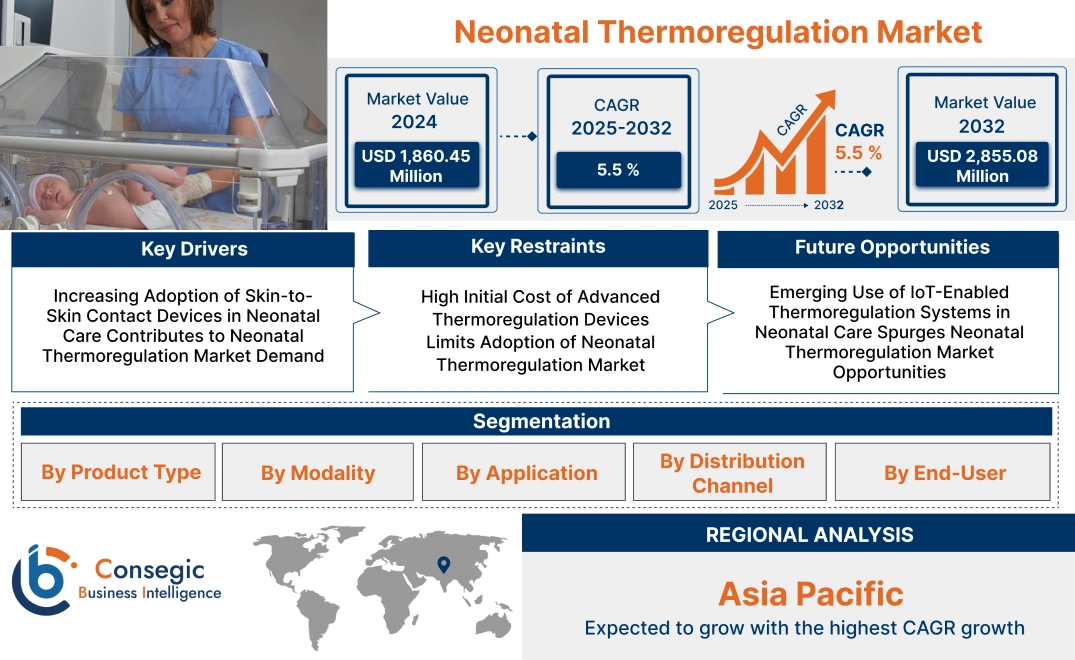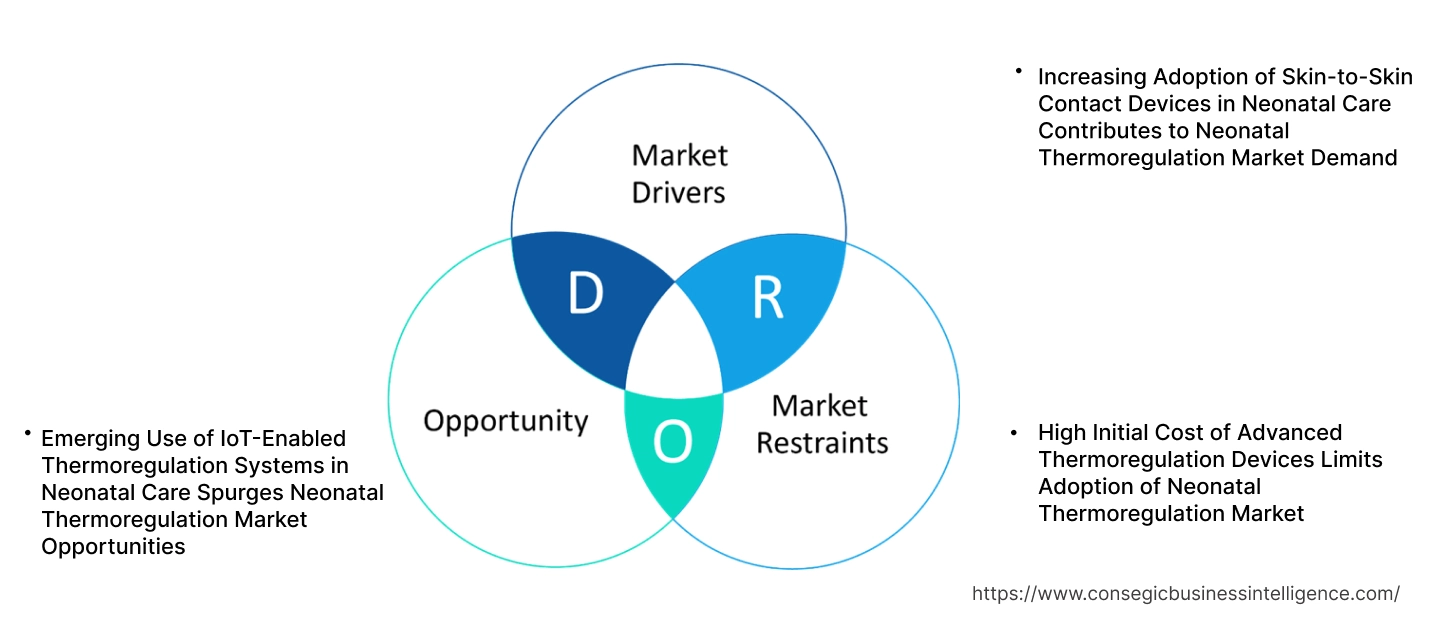- Summary
- Table Of Content
- Methodology
Neonatal Thermoregulation Market Size:
Neonatal Thermoregulation Market size is estimated to reach over USD 2,855.08 Million by 2032 from a value of USD 1,860.45 Million in 2024 and is projected to grow by USD 1,929.62 Million in 2025, growing at a CAGR of 5.5 % from 2025 to 2032.
Neonatal Thermoregulation Market Scope & Overview:
Neonatal thermoregulation involves maintaining optimal body temperature in newborns, ensuring stable metabolic function and preventing hypothermia or hyperthermia. It is critical for neonatal survival and development. Products in this market include incubators, radiant warmers, thermal mattresses, and monitoring devices. These products feature precise temperature regulation, user-friendly interfaces, and integration with neonatal care systems. Advanced designs also enhance efficiency and reduce heat loss.
The benefits include improved neonatal outcomes, reduced risks of temperature-related complications, and enhanced support for premature or low-birth-weight infants. These solutions also contribute to a safer and more comfortable care environment. Applications include neonatal intensive care units, delivery rooms, and postnatal wards. End-use industries include hospitals, pediatric clinics, and home healthcare services focused on neonatal and maternal care.
Key Drivers:
Increasing Adoption of Skin-to-Skin Contact Devices in Neonatal Care Contributes to Neonatal Thermoregulation Market Demand
Skin-to-skin contact is a critical component of neonatal care, promoting thermal stability and physiological benefits for newborns. Devices designed to support this practice, such as specialized incubators or wraps, ensure consistent thermoregulation. These devices are increasingly being adopted in neonatal intensive care units (NICUs) to prevent hypothermia in preterm infants, a common cause of complications in early infancy. For example, the introduction of wraps that mimic maternal body temperature has improved neonatal outcomes significantly.
This growing preference for innovative thermoregulation solutions is enhancing the demand for neonatal thermoregulation products in healthcare facilities globally.
Key Restraints:
High Initial Cost of Advanced Thermoregulation Devices Limits Adoption of Neonatal Thermoregulation Market
Advanced neonatal thermoregulation devices, including incubators and radiant warmers, often come with a high initial cost. This cost is a significant barrier for small and mid-sized healthcare facilities, particularly in developing regions. Additionally, the need for regular maintenance and calibration increases operational expenses, further discouraging adoption. For instance, hospitals in low-income regions often rely on basic warming methods due to budget constraints, leading to underutilization of advanced technologies.
The financial challenges associated with these devices limit their widespread adoption, hindering the neonatal thermoregulation market growth potential.
Future Opportunities :
Emerging Use of IoT-Enabled Thermoregulation Systems in Neonatal Care Spurges Neonatal Thermoregulation Market Opportunities
The integration of IoT into neonatal thermoregulation systems is poised to transform the market. IoT-enabled devices allow real-time monitoring of infant temperature and environmental conditions, enabling precise adjustments and reducing the risk of complications. For example, IoT-based incubators with remote monitoring capabilities are expected to improve neonatal care efficiency and reduce staff workload in NICUs.
As healthcare facilities increasingly prioritize smart technologies, IoT-based thermoregulation systems are anticipated to create substantial neonatal thermoregulation market growth opportunities.
Neonatal Thermoregulation Market Segmental Analysis :
By Product Type:
Based on product type, the neonatal thermoregulation market is segmented into neonatal incubators, neonatal warmers, neonatal cooling systems, and others.
The neonatal incubators segment accounted for the largest revenue in neonatal thermoregulation market share in 2024.
- Neonatal incubators provide a controlled and protective environment for premature and ill newborns, ensuring optimal temperature, humidity, and oxygen levels.
- They are equipped with advanced monitoring systems to ensure continuous observation of vital signs, making them indispensable in neonatal care.
- Their usage is prevalent in hospitals and neonatal intensive care units (NICUs) due to the increasing incidence of preterm births and complications.
- The demand for neonatal incubators is growing due to rising premature birth rates and advancements in incubator technology, such as temperature and humidity control.
- Hospitals are increasingly adopting these systems to improve neonatal care standards and reduce complications associated with birth defects and respiratory conditions.
- Therefore, according to neonatal thermoregulation market analysis, neonatal incubators dominate the market due to their critical role in the care of vulnerable neonates, especially in NICUs, and are expected to maintain their leading position.
The neonatal cooling systems segment is anticipated to register the fastest CAGR during the forecast period.
- These systems are utilized to manage hypoxic-ischemic encephalopathy (HIE) in neonates by reducing the risk of brain damage.
- The adoption of cooling systems is increasing due to growing awareness of their efficacy in improving long-term neurological outcomes.
- Technological advancements have further enhanced their usability and precision in temperature control.
- With growing awareness about neonatal brain health and the effectiveness of therapeutic hypothermia, demand for these systems is expected to rise.
- Neonatal cooling systems are becoming standard in NICUs for managing brain injury and improving survival rates in critically ill neonates.
- Thus, according to neonatal thermoregulation market analysis, the neonatal cooling systems segment is expected to experience rapid trend, driven by technological innovations and the increasing recognition of their importance in neonatal neurological care.
By Modality:
Based on modality, the market is segmented into open care systems and closed care systems.
The closed care systems segment accounted for the largest revenue in neonatal thermoregulation market share in 2024.
- Closed care systems, including incubators, offer a controlled and enclosed environment that minimizes external contamination risks.
- These systems are preferred for critically ill neonates requiring continuous care and monitoring in NICUs.
- Closed care systems help provide consistent and optimal temperature regulation, essential for neonates with compromised health.
- Technological improvements, such as automatic monitoring of vital signs and integration with electronic health records (EHR), have made closed systems more efficient.
- The increasing number of premature births globally further bolsters the demand for closed care systems in hospitals and NICUs.
- Therefore, according to market analysis, closed care systems will continue to dominate the market, owing to their effectiveness in providing a controlled, safe environment for critically ill neonates in NICUs.
The open care systems segment is anticipated to register the fastest CAGR during the forecast period.
- Open care systems, such as radiant warmers, provide easy access to neonates while maintaining optimal temperature regulation.
- They are gaining traction due to their suitability for immediate care in delivery rooms and emergency situations.
- These systems allow healthcare providers to conduct procedures like resuscitation and blood tests without removing the infant from a warm environment.
- The increasing emphasis on providing rapid and efficient neonatal care in emergency settings is contributing to the trend of this segment.
- Technological advancements in radiant warming and improved control over heat distribution make open care systems more effective.
- Thus, according to market analysis, open care systems are expected to experience substantial trend due to their versatility in immediate and emergency care scenarios, particularly in delivery rooms.
By Application:
Based on application, the market is segmented into hypothermia management, hyperthermia management, and temperature monitoring.
The hypothermia management segment accounted for the largest revenue share by 51.60% in 2024.
- Hypothermia management is critical for preterm and low-birth-weight neonates to prevent complications such as infections and respiratory issues.
- Devices like neonatal warmers and incubators are essential in maintaining optimal body temperature.
- Effective hypothermia management helps reduce the risk of complications and improves survival rates in neonates.
- This application is critical in neonatal care, especially in countries with high rates of preterm births.
- As healthcare systems become more advanced, the focus on preventing hypothermic conditions in neonates will continue to drive demand for thermoregulation devices.
- Therefore, according to market analysis, hypothermia management remains the dominant application, driven by the critical need for temperature regulation to ensure the survival and health of neonates.
The temperature monitoring segment is anticipated to register the fastest CAGR during the forecast period.
- Continuous temperature monitoring ensures early detection of abnormalities and enables prompt intervention.
- Increasing adoption of wearable and non-invasive monitoring devices is driving this segment's growth.
- Advances in sensor technology and the development of more precise and user-friendly monitoring systems are further propelling the growth of this segment.
- Temperature monitoring is becoming more integrated into neonatal care protocols, offering continuous, real-time data for clinicians.
- The shift toward patient-centered care and personalized medicine is also driving the demand for advanced temperature monitoring systems.
- Thus, according to market analysis, temperature monitoring is poised for rapid growth due to increasing advancements in monitoring technology, which enable more effective and early interventions in neonatal care.
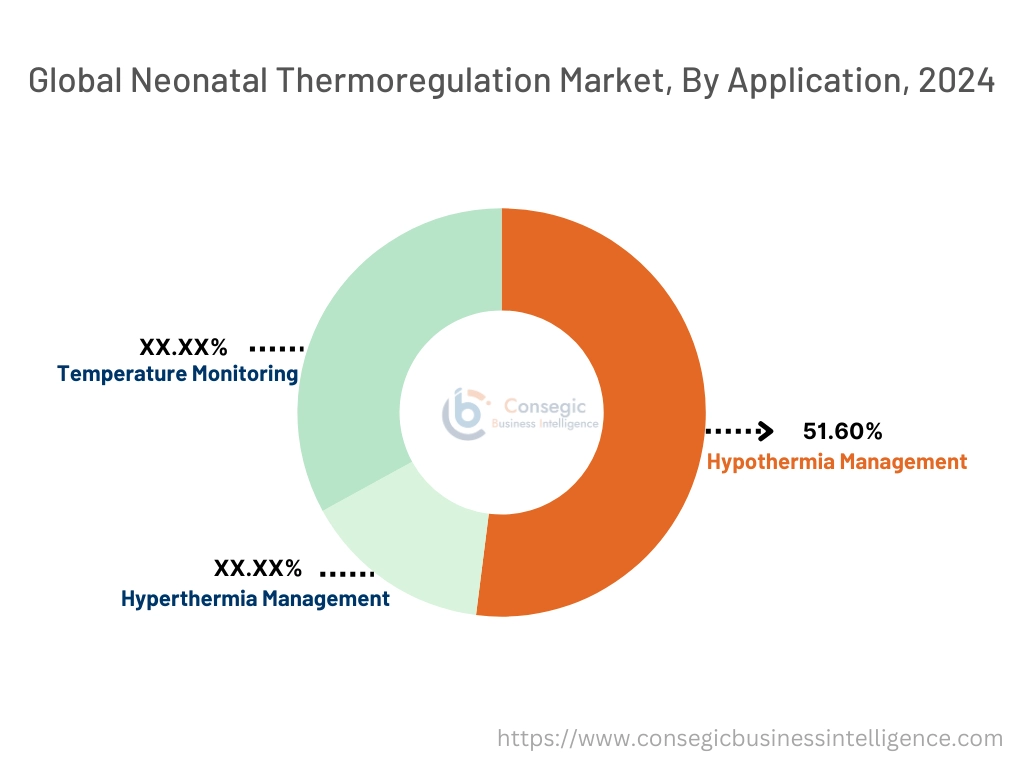
By Distribution Channel:
Based on distribution channel, the market is segmented into hospital pharmacies, retail pharmacies, and online stores.
The hospital pharmacies segment accounted for the largest revenue share in 2024.
- Hospital pharmacies are a primary distribution channel for neonatal thermoregulation devices, ensuring immediate availability for critical care.
- Their centralized procurement systems enhance cost efficiency and inventory management.
- Hospital pharmacies typically maintain a consistent stock of high-demand thermoregulation devices to meet the needs of NICUs and emergency care units.
- Direct relationships with manufacturers ensure that hospitals receive the latest models of thermoregulation equipment for optimal neonatal care.
- Therefore, according to market analysis, hospital pharmacies remain the dominant distribution channel due to their critical role in ensuring the availability of essential thermoregulation equipment for neonatal care.
The online stores segment is anticipated to register the fastest CAGR during the forecast period.
- Online platforms provide convenient access to a wide range of products, often at competitive prices.
- Increased internet penetration and growing trust in e-commerce for medical devices are boosting this segment.
- The ease of purchasing medical equipment through online platforms, especially in regions with limited access to physical stores, is accelerating neonatal thermoregulation market trend.
- The ability to compare prices and access reviews online is encouraging healthcare providers and parents to purchase neonatal thermoregulation devices online.
- Thus, according to market analysis, online stores are set to experience rapid growth, driven by e-commerce trends, increased access to products, and growing consumer confidence in buying medical devices online.
By End-User:
Based on end-user, the market is segmented into hospitals & clinics, neonatal intensive care units (NICUs), and homecare settings.
The neonatal intensive care units (NICUs) segment accounted for the largest revenue share in 2024.
- NICUs are specialized care units equipped with advanced technologies for managing critically ill neonates.
- The increasing establishment of NICUs in healthcare facilities worldwide drives demand for thermoregulation devices.
- NICUs play a critical role in providing comprehensive care to premature and critically ill neonates, thus driving the demand for sophisticated thermoregulation equipment.
- The integration of cutting-edge technologies like IoT and AI into NICUs enhances the effectiveness of thermoregulation devices.
- NICUs benefit from economies of scale and centralized procurement systems, improving cost-effectiveness for hospitals.
- Therefore, according to market analysis, NICUs will remain the largest end-user segment, driven by their critical role in neonatal care and the continuous need for advanced thermoregulation devices in specialized settings.
The homecare settings segment is anticipated to register the fastest CAGR during the forecast period.
- Homecare settings are emerging as a viable option for neonatal care post-discharge, supported by portable and user-friendly thermoregulation devices.
- Rising healthcare costs and a preference for home-based care among parents are contributing to this trend.
- Technological advances in portable thermoregulation devices and the trend of early discharge from hospitals are further boosting this segment.
- Homecare settings offer the flexibility of continued care with fewer hospital visits, improving the quality of life for both neonates and parents.
- The growing availability of homecare solutions, such as portable incubators and warmers, is expanding this market.
- Thus, according to market analysis, homecare settings are expected to experience the highest growth, driven by the increasing shift toward at-home neonatal care supported by portable thermoregulation devices.
Regional Analysis:
The regional segment includes North America, Europe, Asia Pacific, Middle East and Africa, and Latin America.
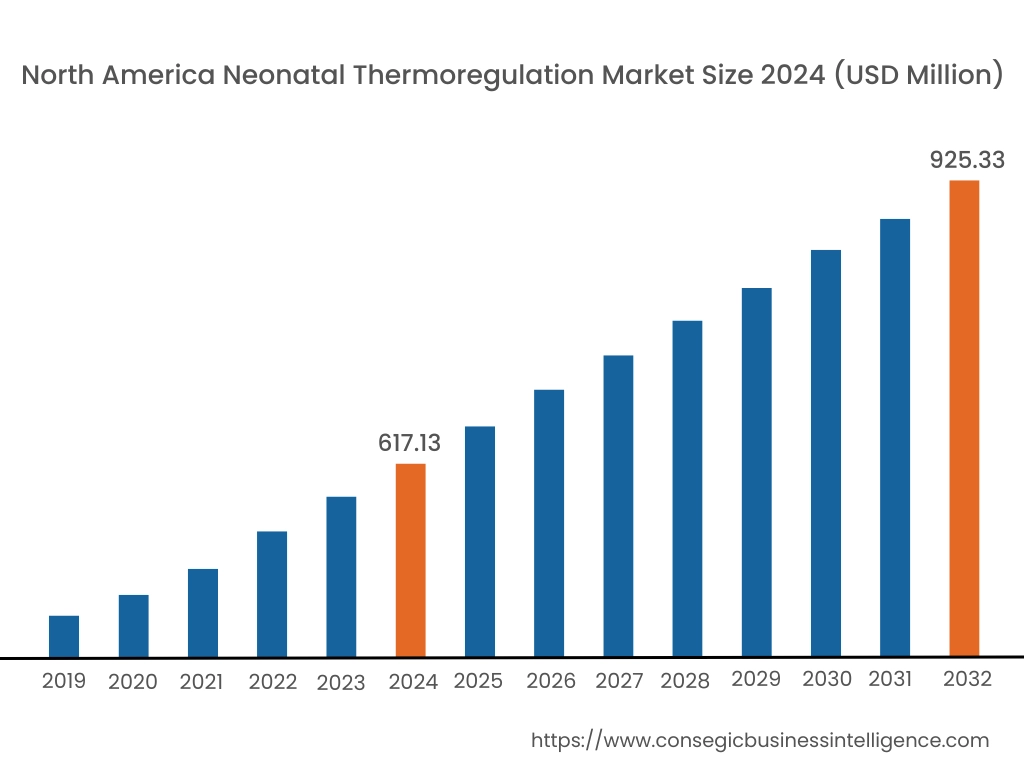
In 2024, North was valued at USD 617.13 Million and is expected to reach USD 925.33 Million in 2032. In North America, the U.S. accounted for the highest share of 70.40% during the base year of 2024. North America is a leading region in the neonatal thermoregulation market, particularly in the United States and Canada. High awareness levels regarding neonatal health and advanced healthcare infrastructure contribute to the demand for neonatal thermoregulation solutions. Hospitals and healthcare facilities in the region are increasingly adopting advanced technologies to ensure the optimal care of premature and low-birth-weight infants. The presence of well-established players in the market, along with supportive government policies related to infant health, further boosts the market. Additionally, the growing number of neonatal intensive care units (NICUs) adds to the demand for thermoregulation products.
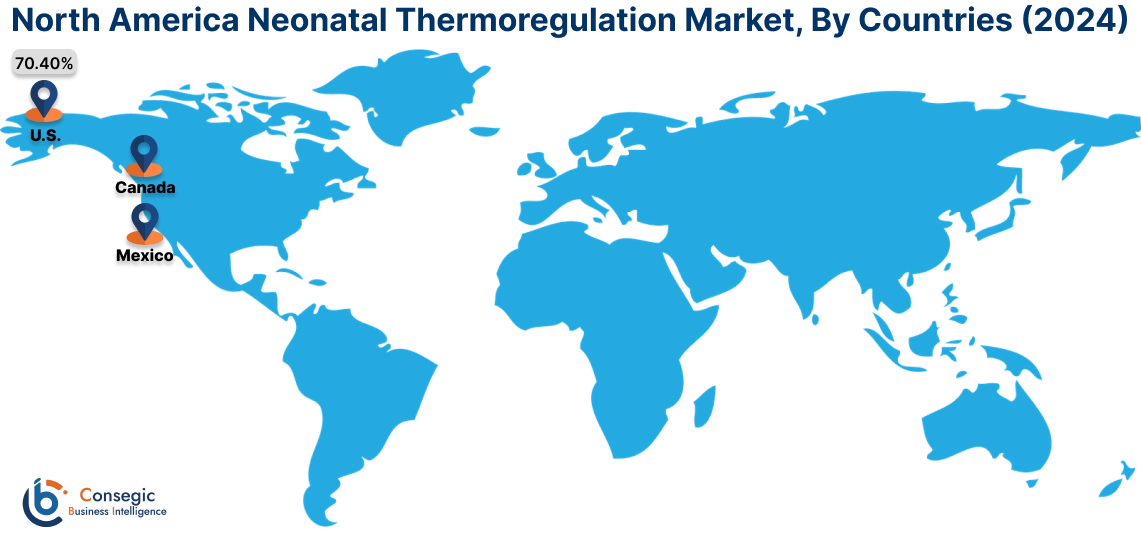
In Asia Pacific, the market is experiencing the fastest growth with a CAGR of 5.9% over the forecast period. Asia-Pacific is experiencing significant neonatal thermoregulation market expansion, driven by rising healthcare investments, improving neonatal care, and a growing healthcare infrastructure. Countries such as China, India, Japan, and South Korea are central to the neonatal thermoregulation market trend. Increasing awareness of neonatal health and the rising number of premature births contribute to the market’s demand for thermoregulation products. However, challenges related to healthcare access in rural areas and limited awareness in some regions may impede market progress. Despite these challenges, urban areas are seeing an increase in the use of advanced neonatal care technologies.
Europe maintains a strong position in the neonatal thermoregulation market, with countries like Germany, France, the UK, and Italy leading the demand. The region benefits from a well-established healthcare system and high standards of neonatal care, which drive the adoption of thermoregulation products. Rising rates of premature births and increasing focus on improving neonatal outcomes contribute to market performance. Additionally, the implementation of stringent healthcare regulations ensures high-quality and effective solutions. Government initiatives aimed at enhancing maternal and neonatal healthcare further support market growth across Europe.
The Middle East and Africa present a mixed landscape for the neonatal thermoregulation market. The Gulf Cooperation Council (GCC) countries, such as the UAE and Saudi Arabia, are witnessing an increase in the adoption of advanced neonatal care technologies, including thermoregulation products. Healthcare investments in these regions, coupled with rising awareness of infant care, are enhancing market prospects. In contrast, sub-Saharan Africa faces challenges such as limited access to healthcare facilities, inadequate neonatal care infrastructure, and lower awareness levels, which hinder market growth. Nonetheless, ongoing healthcare improvements in the region may gradually foster neonatal thermoregulation market expansion.
In Latin America, the neonatal thermoregulation market is developing steadily, with Brazil and Mexico at the forefront. Increasing awareness about neonatal health, a growing focus on improving healthcare infrastructure, and rising numbers of premature births are key factors contributing to neonatal thermoregulation market demand. However, the region faces challenges such as economic constraints and disparities in healthcare access between urban and rural areas. Despite these challenges, the market continues to show potential as healthcare reforms and government initiatives aimed at improving maternal and child healthcare drive the demand for neonatal care technologies.
Top Key Players and Market Share Insights:
The Global Neonatal Thermoregulation Market is highly competitive with major players providing FWA to the national and international markets. Key players are adopting several strategies in research and development (R&D), product innovation, and end-user launches to hold a strong position in the Global Neonatal Thermoregulation Market. Key players in the Neonatal Thermoregulation industry include-
- GE Healthcare (United States)
- Drägerwerk AG & Co. KGaA (Germany)
- Fisher & Paykel Healthcare Corporation Limited (New Zealand)
- Omron Healthcare, Inc. (Japan)
- Smiths Medical (United Kingdom)
- Medtronic PLC (Ireland)
- Philips Healthcare (Netherlands)
- Radiometer Medical (Denmark)
- Stryker Corporation (United States)
- Natus Medical Incorporated (United States)
Neonatal Thermoregulation Market Report Insights :
| Report Attributes | Report Details |
| Study Timeline | 2019-2032 |
| Market Size in 2032 | USD 2,855.08 Million |
| CAGR (2025-2032) | 5.5% |
| By Product Type |
|
| By Modality |
|
| By Application |
|
| By Distribution Channel |
|
| By End-User |
|
| By Region |
|
| Key Players |
|
| North America | U.S. Canada Mexico |
| Europe | U.K. Germany France Spain Italy Russia Benelux Rest of Europe |
| APAC | China South Korea Japan India Australia ASEAN Rest of Asia-Pacific |
| Middle East and Africa | GCC Turkey South Africa Rest of MEA |
| LATAM | Brazil Argentina Chile Rest of LATAM |
| Report Coverage |
|
Key Questions Answered in the Report
How big is the Neonatal Thermoregulation Market? +
In 2024, the Neonatal Thermoregulation Market was USD 1,860.45 million.
What will be the potential market valuation for the Neonatal Thermoregulation Market by 2032? +
In 2032, the market size of Neonatal Thermoregulation Market is expected to reach USD 2,855.08 million.
What are the segments covered in the Neonatal Thermoregulation Market report? +
The diagnosis and end-user industry are the segments covered in this report.
Who are the major players in the Neonatal Thermoregulation Market? +
GE Healthcare (United States), Drägerwerk AG & Co. KGaA (Germany), Medtronic PLC (Ireland), Philips Healthcare (Netherlands), Radiometer Medical (Denmark), Stryker Corporation (United States), Natus Medical Incorporated (United States), Fisher & Paykel Healthcare Corporation Limited (New Zealand), Omron Healthcare, Inc. (Japan), Smiths Medical (United Kingdom) are the major players in the Neonatal Thermoregulation market.
